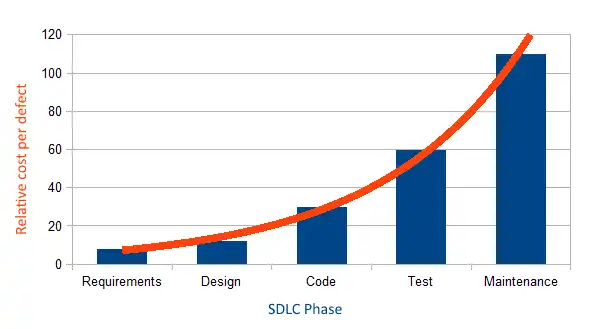
Every Software Development Professional knows the following fact: the later bugs are found, the more expensive they are to fix. Unfortunately, in reality while the majority of bugs are introduced during the coding phase of the development process, most are not actually detected and fixed later on when its much more expensive to fix. To improve efficiency and save money, teams must move the bug detection and repair into the coding stage where it’s less expensive to deal with.
If you take that approach, you’ll get a big payoff, as long as the approach you introduce doesn’t add more cost or effort to your process. This is the immediate value proposition of CodeScan. It’s designed to find critical defects and security vulnerabilities as developers are writing code. Like using a spellchecker, errors can be found and fixed immediately without requiring any significant effort by the developer.

Now that the immediate ROI is clear, let’s briefly review all the factors that give the full ROI picture.
- Maintenance
- Code Reviews
- Time-to-Context
- Onboarding/Training
- Coding Efficiency/Speed
1. Maintenance
CodeScan has been shown to reduce 50% in production bugs and we have observed up to 83% on one our global SI partners.
Bugs are the most time-consuming factor of maintenance and to calculate exact ROI one needs to take into account the time to fix and the overhead including meetings, testing and deployment. And of course the impact on User Experience and Customer Satisfaction.
2. Code Reviews
Static code analysis has been shown to reduce 50% of time spent on code review time as it allows the reviewer to focus purely on semantics as opposed to syntax.
3. Time-to-Context
As a product grows and the number of developers working on it, the Time-to-Context increases. By enforcing the Organization Coding Style with CodeScan, Time-to-Context significantly reduces up to 30% on average.
4. Onboarding and Training
A by-product of Static Code Analysis is that it actually functions as a tutor as well. CodeScan provides new employees that are yet familiar with the Organization rules real-time feedback. It reduces the need for using resources and methodologies for training and developers are not required to read manuals in order to understand the organization’s coding guidelines. Instead, it is given to them through constant automated feedback. Additionally, developers are constantly learning how to code better as potential issues are continuously pointed out to them automatically - how to write better code is a difficult topic to train developers on without a tool like CodeScan.
5. Developer Efficiency
CodeScan IDE Plugins provide real-time automated feedback “as you type”. This allows developers to “navigate” better while they are “driving” and therefore “ship” faster. We’ve summarized general estimates of average savings in the table below.
| Factor | Average Savings |
|---|---|
| Maintenance | 50-85% |
| Code Reviews | 40-50% |
| Time to Context | 50% |
| Onboarding/Training | 30% |
| Developer Efficiency | 25% |
Except for the above key factors, there are of course other factors to consider that are more difficult to measure. These include:
- Increased product quality due to use of best practice standards
- More effective governance
- Reduced design and code re-work
- Fewer process disputes due to a standard “bar” that needs to be reached
- Increased development velocity due to lower technical debt
Estimate your costs with our Plan Calculator.